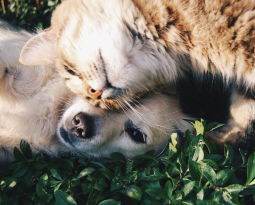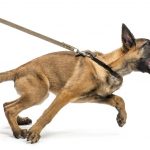Last time on the Acoma Animal Clinic blog we talked a little bit about how to stop dog on dog aggression. We gave a few tips for how to handle it in the moment, but knowing is half the battle! Specifically, knowing what kind of aggression your dog is experiencing and displaying can help you address the root cause of this undesirable behavior. Let’s talk about that!
What is Aggression?
Aggression is the most common, and most serious, behavior problem in dogs. It’s the number one reason pet owners seek out trainers and animal behaviorists.
Aggression actually covers a wide range of behaviors that while appearing similar happen for a huge range of reasons. All wild animals have aggressive behaviors when defending their territory, offspring, or themselves for instance. In this case the behavior is warranted and necessary.
When dogs are ‘aggressive’ that means the behavior from the warning signs to an actual attack.
A sequence of aggression may include any or all of the following behaviors, each increasing in intensity:
- Going very still and rigid
- Guttural bark that sounds threatening
- Lunging forward or charging at the person with no contact
- Mouthing, as though to move or control the person, without applying significant pressure
- “Muzzle punch” (the dog literally punches the person with her nose)
- Growl
- Showing teeth
- Snarl (a combination of growling and showing teeth)
- Snap
- Quick nip that leaves no mark
- Quick bite that tears the skin
- Bite with enough pressure to cause a bruise
- Bite that causes puncture wounds
- Repeated bites in rapid succession
- Bite and shake
Dogs don’t go through this sequence the same way, and often many of these behaviors will be displayed at the same time. The earlier behaviors are the warnings before the bite and if those are misunderstood or not recognized when the dog bites it seems to come ‘out of nowhere.’ This is very rarely the case – animals don’t want to lash out, they want to be left alone or for the irritation to stop, if they can accomplish that with a simple growl, but it can be just a second between the first warning and the bite.
The Types of Dog Aggression
Dogs are aggressive in a few ways, we’ll outline them simply here but know that for every single type of aggression there is plenty to understand. Why it’s being displayed, why your dog in particular has this kind of aggression and how to address it. It’s a little outside the scope of this blog, but knowing the differences is a good first step!
Territorial Aggression
Some dogs display aggression to intruders on their territory, whether that ‘intruder’ is a friend or stranger.
Protective Aggression
When they think their family or friends (human, or fellow pet alike) are in danger, dogs show aggression to try and protect them.
Possessive Aggression
Similar to territorial aggression, many dogs show aggression to guard their possessions from others.
Fear Aggression
A dog that is afraid may display aggression if cornered or otherwise prevented from being able to leave the stressful, scary situation.
Defensive Aggression
Similar to both protective and fear aggression, a defensively aggressive dog is one who has decided that the best defense is going on the offensive.
Social Aggression
Social aggression is displayed when a dog perceives themselves as being higher status compared to other family members and behaves aggressively to keep them in line.
Frustration-Elicited Aggression
Dogs who are overly excited or stimulated by something, but are being held back from approaching or seeing it can display aggression.
Pain-Elicited Aggression
If injured or in pain, even the most friendly and gentle dog can become aggressive.
Sex-Related Aggression
Dogs that are still intact, that is to say have not been spayed or neutered, will still compete for access and attention of other dogs. This competition can often be aggressive. Nature is hard!
Predatory Aggression
Speaking of nature, some dogs will display classic, traditional canine predatory behaviors such as chasing or catching fast-moving things that their brains interpret as prey.
Redirected Aggression
Redirected aggression is a type of aggression that occurs after another type of aggression is already at work. If a dog is agitated or aggressive because of being fearful for instance, and someone/thing interferes the dog may be aggressive towards the interloper.
Do any of these stand out for you and your pup? There may be one clear aggression that seems to have more of a hold on your dog, or a mix of several. Unfortunately we can’t just ask our furry friends what’s wrong so knowing these possibilities and paying attention to their behavior is all we can do to start the process of helping soothe them and curb the aggression.
While we can’t diagnose and address your pups aggression, Acoma Animal Clinic can help keep them healthy, which gives you a solid foundation to work with! Call us today to set up your first appointment and give your dog a healthy life!







